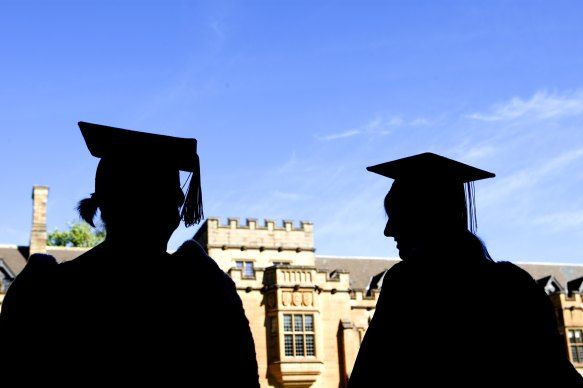This was published 10 months ago
‘It was a shock’: The limit on foreign students for every university revealed
The government has revealed the number of international students each university will be allowed to enrol next year, with vice chancellors saying they were blindsided by limits that kneecap institutions that achieved strong growth this year.
Regional and smaller universities rejected the education minister’s claims that they are the big winners from the upheaval in one of the country’s largest export industries.

International student caps for every university have been revealed. Credit: Peter Braig
Education Minister Jason Clare announced last week there would be 53,000 fewer international students starting their studies next year compared to 2023, with every institution to be given an individual limit under government reforms that still need to pass federal parliament.
He declared the caps would benefit smaller universities and create a fairer playing field after the most prestigious metropolitan universities managed to significantly increase their enrolments this year due to the government’s changes to visa settings.
The caps for each university, tabled at a Senate committee hearing on Friday, showed Sydney University will be limited to 11,900 international students next year, down from 12,790 in 2023.
University of NSW – the hardest hit in NSW – will be limited to 9500 students, which is down from 11,075, while Melbourne University will be limited to 9300.
But the reduction in international students for these universities could be felt more acutely than the government data suggests, because the caps have been calculated based on growth between 2019 and 2023.
Group of Eight universities, including Sydney University, UNSW and Melbourne University, experienced significant growth in 2024, which they will be forced to shed, meaning they will have to slash many thousands more students.
While Clare said the caps would benefit smaller universities, Regional Universities Network chief executive Alec Webb said he had grave concerns the limits would perpetually disadvantage regional universities.
“For some universities, winning has never felt so much like losing,” he told the Senate hearing. “While the cap appears to allow growth ... they remain strongly below pre-pandemic levels.”
Charles Sturt University will be limited to 1000 international enrolments next year, well up on the 162 it had in 2023.
However, that figure is still well below the university’s pre-pandemic number of 3000 new enrolments per year.
“While that would be appropriate for one year we’ve been given no assurance we’ll be able to increase from that number,” vice chancellor Renée Leon said.
Australian Catholic University, which has both regional and metropolitan campuses, said it was blindsided by the formula used to calculate the caps.
“The current legislation punishes universities like ACU without cause,” pro vice chancellor Christopher Riley told the hearing.
“Our indicative cap for 2025 is more than 55 per cent less than our 2024 international commencing enrolments.”
It has been limited to 1700 new students next year, down from 3770 this year and 2212 in 2019.
Western Sydney University vice chancellor George Williams said he was shocked to read a letter outlining the formula used to cap their students.
His university’s cap is similar to 2023 enrolments, but strong recent growth means it still represents 1000 fewer enrolments than expected for next year.
“The formula was a shock, it was not what we expected,” Williams told the hearing. “I read it twice, thinking I had misread.”
Many regional and smaller universities have struggled to enrol students this year due to ministerial direction 107, which aimed to slow down visa processing and prioritise metropolitan universities whose students had the least risk of visa rejections, as the government responded to pressure to reduce migration.
But regional universities that have been given caps higher than their current numbers are concerned they still will not be able to get the visa approvals needed to fill their allocations.
“Regional universities need a pathway to recovery and sustainability. They require a visa processing regime and a cap methodology that provides certainty, transparency, and repeatability,” Webb said.
Private higher education providers say they have been discriminated against by the government and will be forced to make huge cuts and close campuses due to the caps they have been given.
Holmes Institute chief executive Stephen Nagle said his institution, which enrolled more than 8000 new international students in 2019, would be forced to close three of its campuses.
After a gradual COVID-19 recovery, the institution had about 4500 enrolments this year, but its cap for next year will be just 980.
“We’ll have to make 100 staff redundant,” he said. “Who’s going to tell our staff that by Christmas we’re going to have people unemployed?”
Education Department deputy secretary Ben Rimmer said he had not heard of regional universities that would be able to fill a higher cap than they had been given.
Start the day with a summary of the day’s most important and interesting stories, analysis and insights. Sign up for our Morning Edition newsletter.